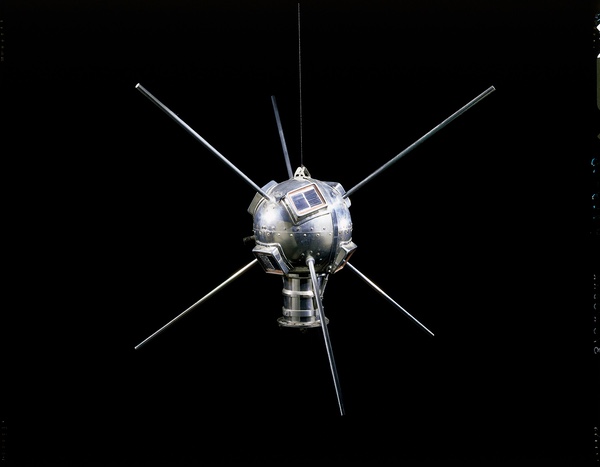Sputnik’s effect on Vanguardby Richard Easton
|
| Roger says, “They launched Sputnik.” And I said, “Good, now we know what can be done.” He said, “You don’t understand; we’ve got to track it.” And I said, “Can I eat supper first?” |
It also had an effect on nascent satellite programs in the United States, like Vanugard, as Marty Votaw recalled. After college in 1947, Martin Votaw worked at the Wave Propagation Research branch at the Naval Research Lab for three years. He then transferred to the Rocket Development branch to work for Roger Easton (my father) and made microwave transmitters for three Viking rocket launches. When the Vanguard program was approved, Votaw was assigned to work on ground antennas for receiving telemetry and tracking signals. He also worked on the small Vanguard 1 satellite.
Marty Votaw offered his recollections at the 50th anniversary of Vanguard 1 in 2008:
The Vanguard program was run on paid overtime from the beginning of the program. On Wednesday [October 2, 1957] at work, a memo came out that said there will be no paid overtime after Friday. And I thought “Phew!” we are going to get some time off.
And Friday came, I went home from work tired, and we had company that night. I sat down to dinner and the phone rang. And Roger says, “They launched Sputnik.” And I said, “Good, now we know what can be done.” He said, “You don’t understand; we’ve got to track it.” And I said, “Can I eat supper first?” He said, “Well, yeah, but come back right afterwards.”
And we worked the next three days without going home. We would go to Blossom Point [where the nearest Minitrack station was located], we made 40 MHz antennas [Vanguard was going to transmit at the IGY standard of 108 MHz whereas Sputnik1 transmitted at 20 and 40 MHz], we had to set up new antennas for each of the Minitrack sites—just a dipole in each one—and we had to run the cables, and these things are a 100 yards apart, or something. They had just plowed the fields to get rid of the weeds and it had rained and it was mud. We would go out and work and get these cables laid and get the antennas stuck in the ground. We would get tired and somebody would bring us food, and we would eat and we would go back and work some more. Then, we would get tired. We would come back and take our jackets off and roll them up for pillows, laid down on the floor of the trailer or the house, or whatever it was, and we would sleep a while. And after three or four hours we would wake up, put our coats on again, and go out and do some more.
And we finally got antennas hooked up and Vick Symus, he was the receiver specialist, so he had to take a mini-track receiver and he had put in a multiplier to get the 40 MHz up to 108. So, he got that done, so we had receivers ready, and we began tracking the signal as it came over. And we would get these long strip charts and Roger would say, “Come on, let’s take them to the computing place.” IBM had set up a special computer center and we would go and knock on the door and they wouldn’t let us in, but they would take the records. As I remember, we did that for two weeks. And, after three days, we got to go home and take a shower and then we went back to work.
So, we were working hard throughout the program and there was never any unpaid overtime. The Sputnik launch overtook the memo. So, the stories about a space race arrived in the newspapers and it was not generated by anybody at NRL. It was not supported by anyone at NRL. NRL’s responses were always based on the program inside and they were always full speed ahead. So, the space race is not a subject that fits into an NRL discussion. Period.
There is speculation that the Eisenhower Administration let the Soviets launch the first satellite since it made clear that space was outside any country’s airspace. Marty’s statement makes it clear that this as not the perspective of Vanguardians. Milt Rosen headed up Project Viking (not to be confused with the later NASA program) and was the technical head of Project Vanguard. His wife Sally came with the name Project Vanguard. She told me in 2009 that she was in Paris with Milt when Sputnik was launched. Their Parisian friends immediately made the connection between launching a satellite and using the rocket as an ICBM.
Thus, there was no conspiracy to allow the Russians to launch first. After Sputnik 2 was launched in November 1957 with a dog Laika onboard, Vanguard TV-3 blew up and was dubbed Flopnik. Von Braun’s team launched the first American satellite, Explorer 1, in January 1958. My father tinkered with the Vanguard 1 satellite on our dining room table. It was launched on March 17, 1958, and is the oldest human object in space today.
Note: we are using a new commenting system, which may require you to create a new account.
